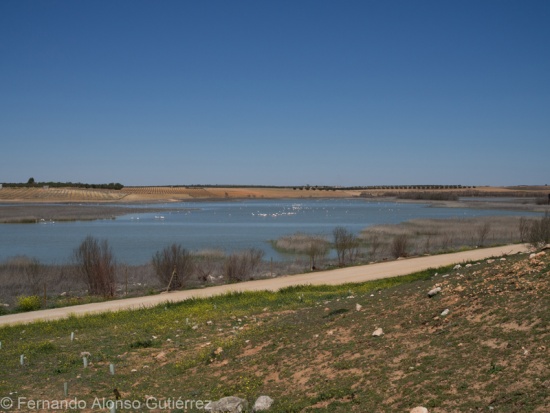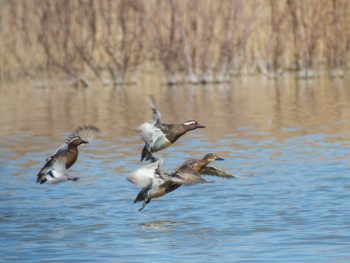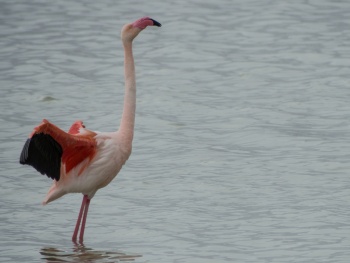Overview
Included in La Mancha wetlands, a large cluster of shallow wetlands associated to the Western Mancha aquifer located in the corner formed by the provinces of Ciudad Real, Cuenca and Toledo, about 150 km SW from Madrid.
Pedro Muñoz complex is made up of three endorheic shallow lakes or lagunas: the main one for birding purposes is Laguna del Pueblo at the very same village of Pedro Muñoz. The other two, Laguna de Navalafuente and Laguna del Retamar, only hold water after sustained rains and for short time.
In a normal year you can expect to find Laguna del Pueblo dry from late July until October. The inflow of untreated sewage from the village did, as in other lakes in the area, modified its original saline character, and as a consequence a fringe of Phragmites reeds has grown around most of the lake. Since 1999, the sewage has been treated and can be diverted from the lake, but eutrophy persists. Also important for birds is the presence of Sea Club-rush Bolboschoenus maritimus, among other macrophytes. A belt of Tamarix shrubs has been planted.
Pedro Muñoz is both Natura 2000 and RAMSAR site.
Birds
Notable Species
Pedro Muñoz qualified as RAMSAR site for reproduction/numbers of Whiskered Tern, Black-winged Stilt, Black-necked Grebe and Red-crested Pochard reproduction. There is also a breeding colony of Black-headed Gull, sometimes Mediterranean Gull is also seen.
Several hundreds of Greater Flamingo move all year round (if the water levels allow) between here and the nearby Lagunas de Alcázar and Lagunas de Manjavacas, but is here where you can have the closer views of this species. White-headed Duck, Red-crested Pochard and Black-necked Grebe are other typical specialties that can be seen, mainly during spring.
The reedbeds are home, among other warblers, to Savi's Warbler, Bearded Tit and Penduline Tit, as well as Reed Bunting Cetti's Warbler and Spanish Sparrow. Marsh Harrier breeds frequently.
Winter wildfowl includes Gadwall, Mallard, Common Teal, Common Shelduck, Northern Shoveler, Common Pochard and Eurasian Coot and, to a lesser extent Greylag Goose. Eurasian Wigeon and Northern Pintail are scarcer but common visitors. Little Grebe is another common species.
Waders on passage including Pied Avocet, Black-winged Stilt Ruff, Black-tailed Godwit, Dunlin and Common Redshank and also some Common Greenshank, Green Sandpiper and Wood Sandpiper. Plovers are also common: both Ringed Plover, Little Ringed Plover and Kentish Plover. Small numbers of Garganey can be seen at that time.
A good place for spotting European Roller is the Záncara, 7 km away. Take road CM-3103 towards Tomelloso and just before crossing river Záncara turn left to Ermita de San Miguel (39.350117, -2.930160). Drive the dirt track upstream until arriving at a pine stand, checking the riverside trees.
Check-list
Little Grebe, Black-necked Grebe, Little Bittern, Cattle Egret, White Stork, Greylag Goose, Common Shelduck, Eurasian Wigeon, Gadwall, Common Teal, Mallard, Northern Pintail, Garganey, Northern Shoveler, Red-crested Pochard, Common Pochard, White-headed Duck, Black Kite, Short-toed Eagle, Western Marsh Harrier, Common Buzzard, Booted Eagle, Lesser Kestrel, Common Kestrel, Sparrowhawk, Red-legged Partridge, Water Rail, Common Moorhen, Western Swamphen, Greater Flamingo, Eurasian Coot, Pied Avocet, Black-winged Stilt, Stone-curlew, Collared Pratincole, Common Ringed Plover, Little Ringed Plover, Kentish Plover, Northern Lapwing, Dunlin, Ruff, Little Stint, Curlew Sandpiper, Common Snipe, Green Sandpiper, Wood Sandpiper Common Sandpiper Black-tailed Godwit, Eurasian Curlew, Common Redshank, Common Greenshank, Black-headed Gull,Mediterranean Gull Lesser Black-backed Gull, Yellow-legged Gull, Gull-billed Tern, Whiskered Tern, Black Tern, Pin-tailed Sandgrouse, European Turtle Dove, Eurasian Collared Dove, Common Wood Pigeon, Great Spotted Cuckoo, Common Cuckoo, Eurasian Scops Owl, Little Owl, European Bee-eater, European Roller,Eurasian Hoopoe, Calandra Lark, Crested Lark, Barn Swallow, Water Pipit, Meadow Pipit, Bluethroat, Cetti's Warbler, Savi's Warbler, Zitting Cisticola, Common Reed Warbler, Great Reed Warbler, Willow Warbler, Common Chiffchaff, Bearded Tit, Penduline Tit, Iberian Grey Shrike, Common Starling, Eurasian Tree Sparrow, Spanish Sparrow,European Greenfinch,European Serin, Common Linnet, Corn Bunting, Reed Bunting
Other Wildlife
Red Fox inhabit the reedbeds and are seen eventually crossing the lake. Rabbit is very abundant around the Tamarix
Site information
History and Use
Its situation inside the village made Laguna del Pueblo highly vulnerable to human pressure, being perceived by locals as a nuisance to human health and village development. A raised track for tractors crossed through the middle of the lake, which was also used as irregular dumpsite. This changed when in 1987 the regional government bought the terrains, and gave the wetland a protection status.
At the start of the 1990's: the road was eliminated, a shallow island was created as habitat enhancemente , the lake was fenced to prevent illegal dumping and Tamarix were planted. In 1999 the village sewage plant was completed: now it allows either put into the lake treated sewage or to take it away to river Záncara.
Unfortunatley, the conservational actions seems to have lost some momentum in the last years. During 2014 perhaps the best hide was set on fire and destroyed, without plans to recover it for public use being expected. A new hide has been erected in 2016 in a very weird place at the N end of the lake, out and without views of the main waterbody, being virtually useless
Access and Facilities
Pedro Muñoz is on national road N-420 from Cuenca to Ciudad Real, just 15 km from Mota del Cuervo and 25 km from Alcázar de San Juan. Distance to Madrid is 165 km.
Coming from Mota de Cuervo and roughly in front of Hostal “La Parada” (good place for lunch) and the free public parking you can take a dirt road that leads to the east side of the lake, with a hide on top of a small hill overlooking the and a wooden tower useful for seeing the Greater Flamingo at close range when that side of the lake holds water (best with morning light).
A little further inside the town, just by a small petrol station, the road signposted to El Toboso takes you to an earth-paved free car park in the west side. There is an interpretation centre called “El Humedal del Quijote” (i.e. Don Quixote’s wetland), using which was the old municipal swimming pool facilities. They offer guided tours (not needed really for birders) but you can walk inside and gather if there is any interesting bird around. The place of the swimming pool is occupied by a small pond. Opening hours are not particularly visitor-friendly, being closed in the afternoon during weekends. Access is public to the perimeter of the lake.
There are three hides in this side of the lake, two concrete ones and a larger, wooden one, close to the general public (!). The best open one was intentionally burned in 2014 and it doesn’t seem to be plans to restore it, as the perimeter has been recently fenced without leaving place for it.
Binoculars can be enough for birding at Pedro Muñoz, but as always with wetlands a scope recommended.
It is highly recommended to combine in the same day the visit to Pedro Muñoz with Laguna de Manjavacas and perhaps Lagunas de Alcázar, or in a weekend including also other areas at La Mancha wetlands, or even the not so far Laguna de Navaseca and Tablas de Daimiel National Park combo.
Both accommodation and restaurants are available in Pedro Muñoz. There is also a supermarket by the public car park.
Contact Details
For more information regarding the Visitor's Center you can contact with Ayuntamiento de Pedro Muñoz Plaza de España, 1 13620 Pedro Muñoz, Ciudad Real Phone 926 58 6001 (only mornings 9 a.m. to 2 p.m., work days) e-mail: [email protected]
External Links
- LIFE+ La Mancha Wetlands Project webpage
- SEO Leaflet (in Spanish)
- Laguna de Pedro Muñoz on Googlemaps
Content and images originally posted by Fernando Alonso (fdokykcu)






